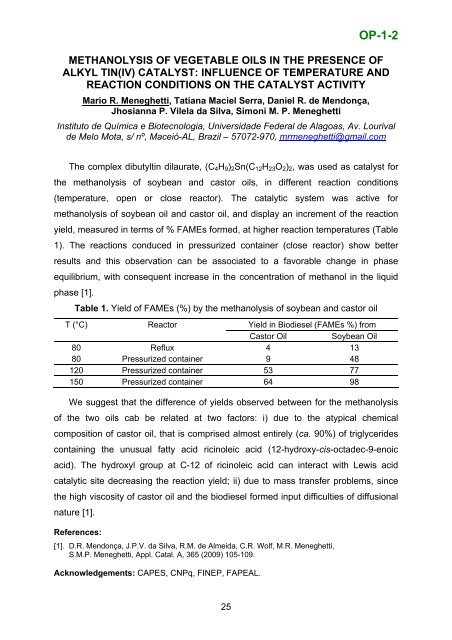Boreskov Institute of Catalysis SB RAS, Novosibirsk, Russia
Boreskov Institute of Catalysis SB RAS, Novosibirsk, Russia
Boreskov Institute of Catalysis SB RAS, Novosibirsk, Russia
- No tags were found...
Create successful ePaper yourself
Turn your PDF publications into a flip-book with our unique Google optimized e-Paper software.
OP-1-2METHANOLYSIS OF VEGETABLE OILS IN THE PRESENCE OFALKYL TIN(IV) CATALYST: INFLUENCE OF TEMPERATURE ANDREACTION CONDITIONS ON THE CATALYST ACTIVITYMario R. Meneghetti, Tatiana Maciel Serra, Daniel R. de Mendonça,Jhosianna P. Vilela da Silva, Simoni M. P. MeneghettiInstituto de Química e Biotecnologia, Universidade Federal de Alagoas, Av. Lourivalde Melo Mota, s/ nº, Maceió-AL, Brazil – 57072-970, mrmeneghetti@gmail.comThe complex dibutyltin dilaurate, (C 4 H 9 ) 2 Sn(C 12 H 23 O 2 ) 2 , was used as catalyst forthe methanolysis <strong>of</strong> soybean and castor oils, in different reaction conditions(temperature, open or close reactor). The catalytic system was active formethanolysis <strong>of</strong> soybean oil and castor oil, and display an increment <strong>of</strong> the reactionyield, measured in terms <strong>of</strong> % FAMEs formed, at higher reaction temperatures (Table1). The reactions conduced in pressurized container (close reactor) show betterresults and this observation can be associated to a favorable change in phaseequilibrium, with consequent increase in the concentration <strong>of</strong> methanol in the liquidphase [1].Table 1. Yield <strong>of</strong> FAMEs (%) by the methanolysis <strong>of</strong> soybean and castor oilT (°C)ReactorYield in Biodiesel (FAMEs %) fromCastor OilSoybean Oil80 Reflux 4 1380 Pressurized container 9 48120 Pressurized container 53 77150 Pressurized container 64 98We suggest that the difference <strong>of</strong> yields observed between for the methanolysis<strong>of</strong> the two oils cab be related at two factors: i) due to the atypical chemicalcomposition <strong>of</strong> castor oil, that is comprised almost entirely (ca. 90%) <strong>of</strong> triglyceridescontaining the unusual fatty acid ricinoleic acid (12-hydroxy-cis-octadec-9-enoicacid). The hydroxyl group at C-12 <strong>of</strong> ricinoleic acid can interact with Lewis acidcatalytic site decreasing the reaction yield; ii) due to mass transfer problems, sincethe high viscosity <strong>of</strong> castor oil and the biodiesel formed input difficulties <strong>of</strong> diffusionalnature [1].References:[1]. D.R. Mendonça, J.P.V. da Silva, R.M. de Almeida, C.R. Wolf, M.R. Meneghetti,S.M.P. Meneghetti, Appl. Catal. A, 365 (2009) 105-109.Acknowledgements: CAPES, CNPq, FINEP, FAPEAL.25
















